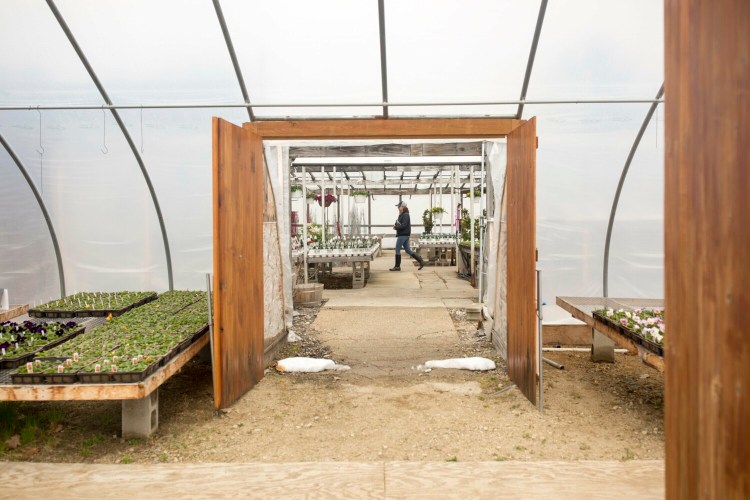When I telephoned landscape and gardening professionals to ask their predictions for trends of the coming year, I received a lot of serious answers, covering COVID-19, supply-chain issues and pesticide regulations.
I’ll get to those, but I’m going to open with moss poles. I had never heard of them, but they sound simple and fun and might give gardeners something to do until it’s time to plant seedlings indoors or to garden outdoors.
Phil Roberts of Broadway Gardens in South Portland and Westbrook was sold out of moss poles when we spoke, but he was ordering more. And, if you can’t find them for sale, they aren’t hard to make.
Moss poles act as supports for two categories of plants: climbers and sprawlers. The poles can be as short as 18 inches and as tall as your ceiling and are designed to mimic trees that other plants would climb in a rain forest. Epiphytes, such as monstera, philodendron and pothos, are the best candidates for climbing the pole as their tendrils will attach to the moss. That said, tying the stems to the pole helps.
To build one, start with the pole, which can be a dowel, a PVC pipe, a straight branch or a length of bamboo. Traditionally, you’d next add dampened sphagnum moss, but today most people use coir from coconuts, or sometimes fiber mats. Whichever you use, soak the material thoroughly. Then, using a strong string such as fishing line or jute, tie a layer of fiber, half to 1-inch thick, around the pole. Be sure to leave the bottom of the pole bare so you can stick it into your plant pot.
Now, on to the serious stuff.
Ryan Russell of Land Plans, landscape architects in Cumberland and current president of the Maine Landscape & Nursery Association, supplied a list of issues he expects the industry to face in 2022.
Labor shortages for one, he said, “despite efforts to increase pay.” That shortage covers the gamut from employees at the nurseries where you buy your plants to landscapers and laborers who visit homes to mow the lawn and do other gardening work. All are busier than ever, in part because many people who’ve been working from home during the pandemic have turned their attention to their yards. My advice to readers is to be patient and kind to any workers you do manage to hire, because they are likely to be stressed and busy in the coming gardening season, as they have been for the past two years.
Russell added that the gardening industry will have to continue to adjust, as more communities have limited or outright prohibited the use of pesticides.
Jake Pierson of Pierson Nurseries, a wholesale plant supplier in Dayton, observed that not only are many people showing more interest in plants, they are becoming more knowledgeable.
“The interest in natives has increased dramatically,” he said, and that encompasses cultivars of natives.
It is not only homeowners who are switching to native plants, he said, but also commercial properties and municipalities in search of new street trees to replace ashes, which are likely to succumb to the emerald ash borer. The bad news? Higher sales of native plants has resulted in a severe shortage of the more mature native trees and shrubs. Most of the larger native saplings have been sold, he said, also the larger non-native saplings and shrubs, too. In ordinary times, the nursery would have continued to grow the smaller saplings before selling them, which takes time. Large plants, of course, can’t be created in a factory. Instead, these smaller saplings are what you’ll find for sale if you go shopping for trees and shrubs.
While planting trees and shrubs when they are smaller is often better for them, Pierson agreed, that’s only the case if the new plants will be carefully watered and pruned. But many of the trees his company sells are put in by contractors at commercial sites and subdivisions and won’t get such tender care. In those cases, he said, the big trees do better.
And when, I asked, does he think the shortage of bigger saplings will end? “That won’t happen until we have our next recession,” he replied.
Regardless of the shortage, Pierson said he’s pleased with his company’s shift to growing more natives and supplying such plants to groups like Maine Audubon, which has an annual native plant sale.
Mike Skillin of Skillins Greenhouse’s Falmouth branch echoed Russell and Pierson, and added a psychological twist.
“People are feeling a lot of stresses in their life,” he said, “and they have turned to their gardens to relieve those stresses.”
They want items in their garden, both plants and accessories, that make them feel better. The garden centers want to provide those.
“Despite all the noise and headlines,” he said, “we are all in this together. We want to help each other.”
Tom Atwell is a freelance writer gardening in Cape Elizabeth. He can be contacted at: tomatwell@me.com.
Copy the Story LinkSend questions/comments to the editors.



Success. Please wait for the page to reload. If the page does not reload within 5 seconds, please refresh the page.
Enter your email and password to access comments.
Hi, to comment on stories you must . This profile is in addition to your subscription and website login.
Already have a commenting profile? .
Invalid username/password.
Please check your email to confirm and complete your registration.
Only subscribers are eligible to post comments. Please subscribe or login first for digital access. Here’s why.
Use the form below to reset your password. When you've submitted your account email, we will send an email with a reset code.